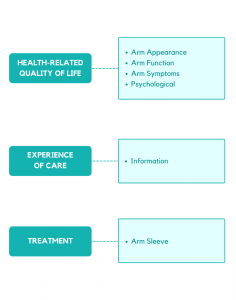Research
Can be used in research studies and clinical trials to study different approaches to treatments.
The LYMPH-Q | Upper Extremity was developed from 15 concept elicitation interviews with women treated for breast cancer who developed arm lymphedema. To further establish content validity, we performed 16 cognitive interviews, and obtained input from 12 clinical experts. The LYMPH-Q was then field-tested in a sample of 3222 women with arm lymphedema from the USA and Denmark.

The LYMPH-Q | Upper Extremity includes 7 independently functioning scales measuring function, symptoms, appearance, life impact, psychological, arm sleeve, and information. The variety of scales provides flexibility to choose the subset of scales best suited to measure the outcomes of interest in any given study or clinical situation.
Can be used in research studies and clinical trials to study different approaches to treatments.
Carefully designed to meet the requirements of regulatory bodies.
Can be used to benchmark outcomes in quality improvement initiatives.
Designed using a modern psychometric approach to facilitate use in patient care.
The rapidly emerging field of lymphedema research has had little consensus on the most suitable metric for measuring outcomes. The LYMPH-Q | Upper Extremity represents a rigorously developed patient-reported outcome measure that can be used to evaluate outcomes important to women with arm lymphedema following treatment for breast cancer. This instrument measures 3 overarching domains. Each domain includes 1 or more independently functioning scales. Clinicians and researchers are able to administer the subset of scales relevant to their situation.
This 12-item scale measures arm function. Items ask about putting on clothes, holding a phone, using hand and fingers, and reaching.
This 15-item scale measures how the arm feels. Items ask about pain, numbness, pressure, feeling tired, etc.
This 10-item scale measures the appearance of the arm with lymphedema. Items ask about how the arm looks in photos, in sleeveless and long-sleeved shirts, overall size of the arm, how clothes fit the arm, etc.
This 12-item scale measures the impact of arm lymphedema on how patients feel. Items ask how often they felt hopeless, depressed, fed-up, unattractive, frustrated, etc.
This 9-item scale measures the patient’s experience of care in terms of satisfaction with the information they received about arm lymphedema, such as how lymphedema is treated, how to avoid infections, and how lymphedema can feel.
This 10-item scale measures satisfaction with the use of an arm sleeve for lymphedema. Items ask how the arm sleeve fit, how helpful it was in reducing swelling, how easy it was to put on, how comfortable it was to wear, etc.


